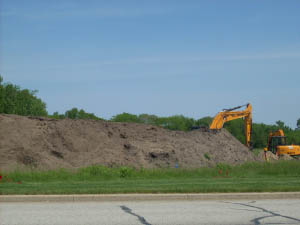Written by Amanda Watson, Marketing Director (Portage, IN)
As a person who works for a company in real estate development, I can’t tell you how excited I get by great big piles of dirt. Why, you may ask? Because I know what that big pile of dirt means. It means work! It means development! It means something new is coming!
I have to say that seeing a pile of dirt, along with accompanying earth-moving equipment, brings a smile to my face…especially when it’s on a Holladay Properties site. I love seeing an empty piece of land transform into a beautiful, finished building; and step one of that process, is great big piles of dirt!
So this morning as I came into work, I saw four separate sites in our AmeriPlex at the Port development with great big piles of dirt on them and I got excited; which got me thinking about other great things about dirt. So I did so research and this is what I discovered…
- It’s not dirt, it’s SOIL. Okay, so technically that top layer of earth that covers most of our planet is referred to as soil and is made up of more than just dirt. (Spilsbury, 2011)
- Soil is used for EVERYTHING! From growing food, to storing and filtering water, to making bricks and for building foundations, to decomposing garbage, soil is seriously important to life everywhere. (Spilsbury, 2011)
- Soil contains pieces of rock that has weathered or eroded over hundreds of years, pieces of waste left behind by living things like decaying leaves, and water and air collecting in the spaces between the rock grains. (Lawrence, 2013)
- Lots of animals make their homes underground including worms, beetles, rabbits and prairie dogs. These animals help loosen and mix up the soil, which helps spread minerals around, adding nutrients, improving soil quality and helping the plants that we need to live survive and thrive. (Spilsbury, 2011)
- There are lots of different types of soil that are categorized by color, texture and where they’re located on the planet, specifically climate zone. (Spilsbury, 2011)
- For centuries, people have eaten clay as a remedy for stomach pain and it’s still used today in Kaopectate and other medicines. Certain types of clay have also been used to counteract the effects of poison. (Root-Bernstein, 1997)
- There are four main soil textures, which are based on the size of the rock particles they contain: gravel, sand, silt and clay. (Root-Bernstein, 1997)
- Clay has the smallest soil size and holds the most water. The Leaning Tower of Pisa in Italy is leaning because it is built on clay. (Spilsbury, 2011)
- There are four main layers of soil: topsoil, the top layer which contains most of the organic material; subsoil, the layer beneath the topsoil where minerals are concentrated; weathering horizon, the layer where bedrock starts to break down; and bedrock, the solid rock that forms the base of the soil. (Spilsbury, 2011)
- Some particles in soil are actually stardust from the hundreds of stars that have fallen to Earth over the centuries. (Coulter)
So the next time you see a great big pile of dirt…or, excuse me, SOIL, remember to think of it as more than just a mess. It’s so much more than a pile of brown stuff; it’s the foundation of everything!
Coulter, L. (n.d.). Fun Facts About Garden Soil. Retrieved June 4, 2015, from HGTV.com: http://www.hgtvgardens.com/soil/fun-facts-about-garden-soil
Lawrence, E. (2013). Dirt. New York: Bearport Publishing Company, Inc.
Root-Bernstein, R. a. (1997). Honey, Mud, Maggots, and Other Medical Marvels. New York: Houghton Mifflin Company.
Spilsbury, R. a. (2011). Let’s Rock Soil. Chicago: Heinemann Library.

